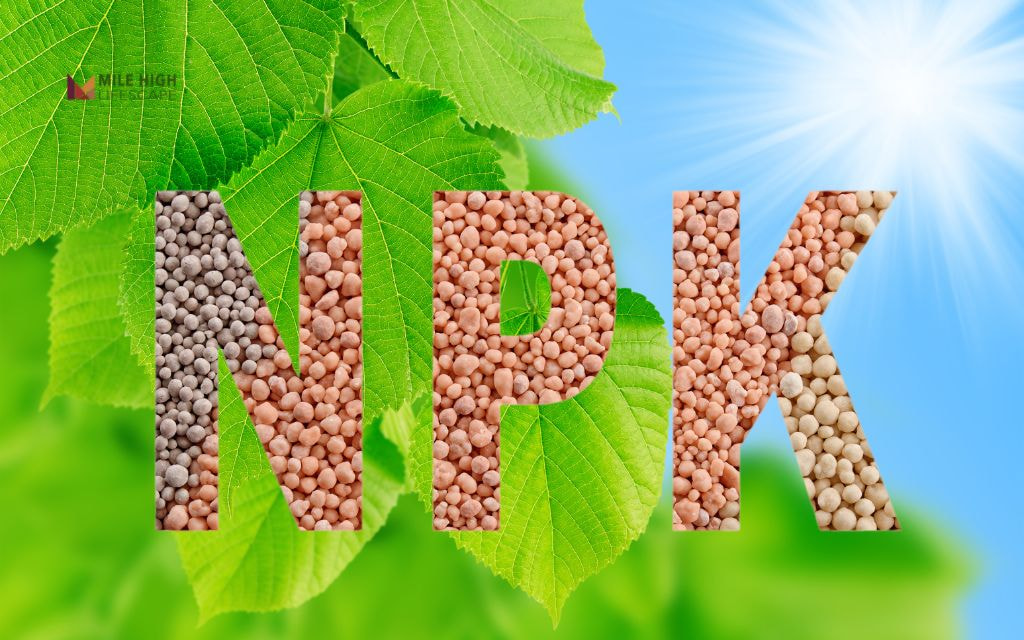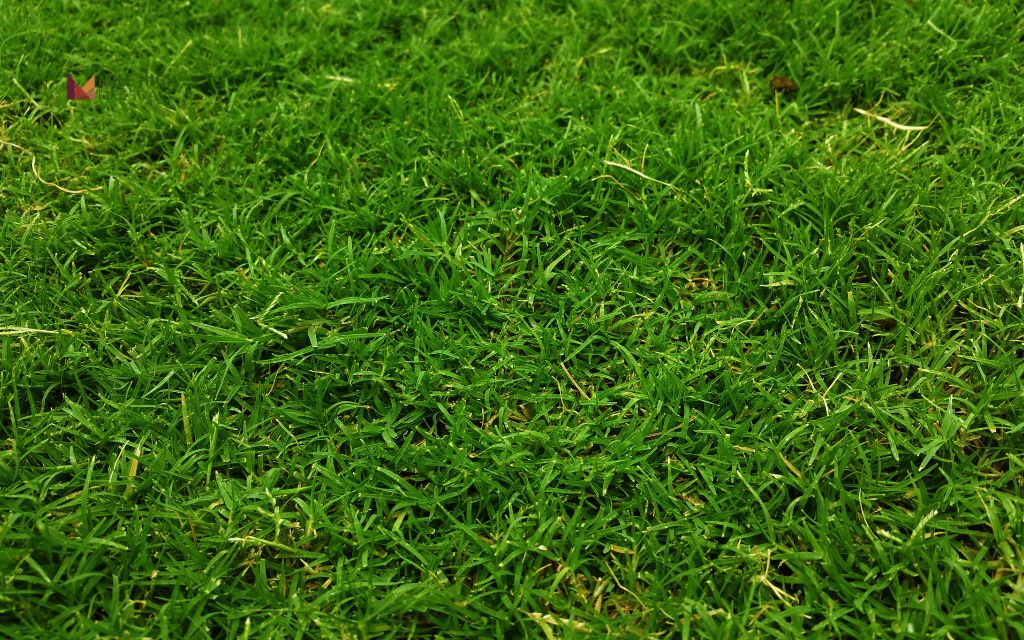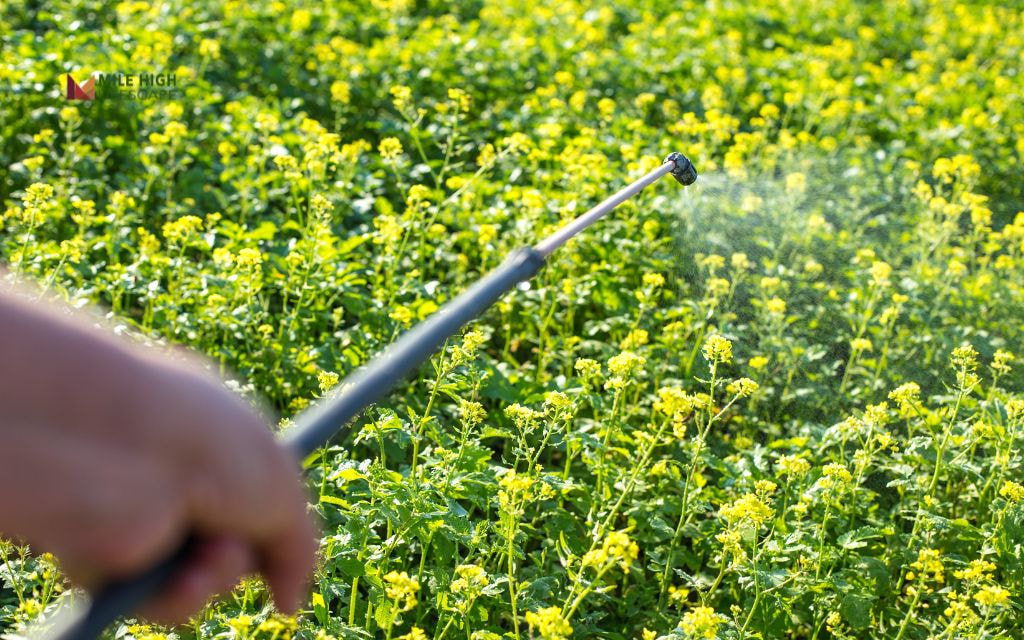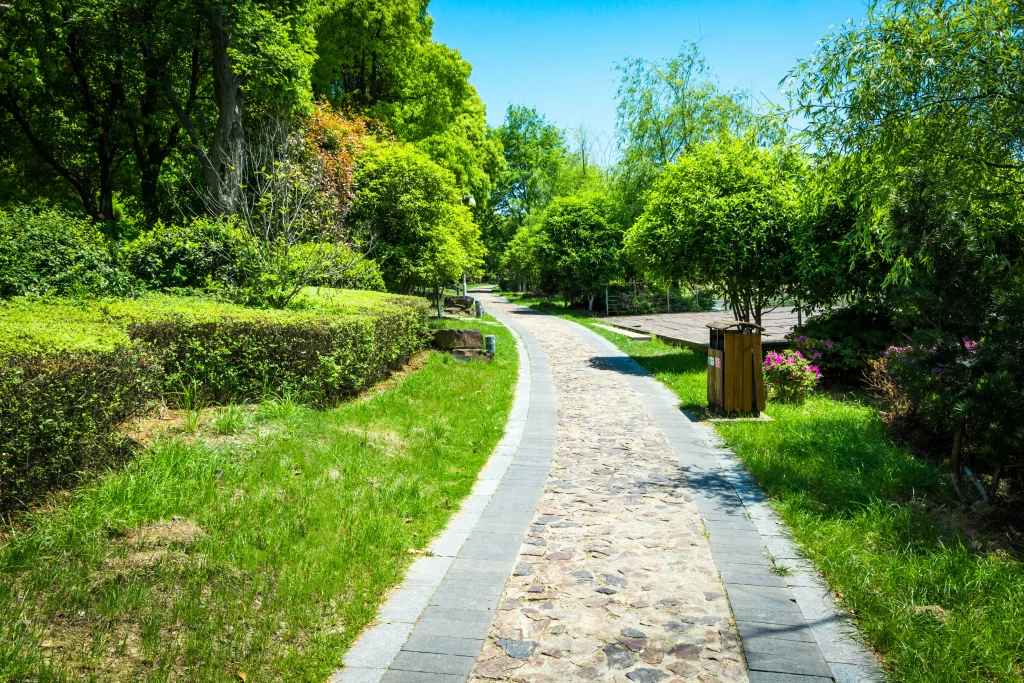How much fertilizer for lawn in Denver? For most lawns, you’ll need to apply fertilizer at a rate of 0.5 to 1 pound of actual nitrogen per 1,000 square feet. This is typically done in 5-6 applications throughout our unique growing season, with a maximum of 1 pound of nitrogen per application to avoid burning your grass in our high-altitude environment.
Fertilizing your lawn is essential for maintaining that lush, green carpet we all desire in the Mile High City – but using too much or too little can lead to disappointing results or even environmental harm.
This comprehensive guide will walk you through exactly how to calculate the proper amount of fertilizer your Denver lawn needs. We’ll explain how to read fertilizer labels, measure your lawn area accurately, and apply the right rate considering Denver’s specific climate, altitude, and soil composition.
Understanding Fertilizer Labels: N-P-K and Application Rates
Every fertilizer bag displays 3 prominent numbers separated by hyphens, such as “25-5-10.” This is the N-P-K ratio, representing the percentage by weight of the 3 primary nutrients plants need:
- N (Nitrogen): Promotes leafy growth and vibrant green color
- P (Phosphorus): Supports root development and establishment
- K (Potassium): Enhances overall plant health, disease resistance, and drought tolerance
When lawn care experts recommend applying “1 pound of nitrogen per 1,000 square feet,” they’re referring to the actual weight of nitrogen, not the weight of the fertilizer product.
To determine how much fertilizer for lawn to apply, you need to calculate based on the nitrogen percentage. For example, in a 40-pound bag of 25-5-10 fertilizer:
- 25% of the bag (10 pounds) is actual nitrogen
- 5% of the bag (2 pounds) is phosphate
- 10% of the bag (4 pounds) is potash
Pro Tips: Colorado restricts phosphorus (P) use in fertilizers unless soil tests indicate a deficiency. This is to protect our watershed from phosphorus runoff, which can cause algae blooms in our waterways.
Most established Denver lawns already have adequate phosphorus levels, so look for fertilizers with low or zero phosphorus content unless a soil test shows your lawn needs it.

Step 1: Measure Your Lawn Area Accurately
Before you can determine how much fertilizer for lawn to apply, you need to know exactly how large your lawn is.
How to measure your lawn:
- Break your yard into simple shapes – rectangles, triangles, or circles
- Measure each area separately using a long tape measure
- Calculate the area of each section using the appropriate formula
- Add all sections together for your total lawn area
Example Calculation:
- Front yard (rectangle): 40 ft × 20 ft = 800 sq ft
- Side yard (rectangle): 60 ft × 10 ft = 600 sq ft
- Backyard (rectangle): 30 ft × 30 ft = 900 sq ft
- Circular garden (subtract): π × (5 ft)² = 78.5 sq ft
Total lawn area: 800 + 600 + 900 – 78.5 = 2,221.5 sq ft
For Denver homes with irregular lawns, consider these alternatives:
- Use Google Earth or satellite imagery to measure your property
- Use a free online lawn measurement tool
- Use a rolling measuring wheel, which works well on uneven terrain common in foothill properties
Important Formula:
Area (sq ft) ÷ 1,000 = “units” for fertilizer application rate
Example: 2,221.5 sq ft ÷ 1,000 = 2.22 units
Step 2: Determine the Recommended Fertilizer Rate
Denver’s high altitude, arid climate, and temperature extremes create unique challenges for lawn care. The fertilizer rate you need depends on both your grass type and the time of year.
Most Denver lawns consist of cool-season grasses like Kentucky Bluegrass and various Fescues. These grasses typically require 2-4 pounds of nitrogen per 1,000 square feet per year, applied in multiple applications rather than all at once.
The standard recommendation for each application is between 0.5 and 1.0 pounds of nitrogen per 1,000 square feet, but this varies by season:
| Season | Nitrogen Rate (per 1,000 sq ft) | Purpose | Denver-Specific Timing |
| Early Spring | 0.5 lbs | Wake up the lawn, stimulate growth | Mid-April to early May |
| Late Spring | 0.75 lbs | Support continued greening and density | Late May to early June |
| Summer | 0.5 lbs (if needed) | Maintain color during heat stress | July (only if irrigated) |
| Early Fall | 0.75 lbs | Recovery from summer stress | Early September |
| Late Fall | 1.0 lbs | Strengthen roots before winter | Late October to early November |
Denver Climate Considerations:
- Our high-altitude sun is more intense, which can stress lawns
- Denver’s clay soils retain nutrients longer but can be prone to compaction
- Our growing season is shorter than lower elevations
- The most important fertilizer applications in Denver are early fall and late fall
- Avoid fertilizing during July drought periods unless your irrigation system is functioning optimally

Step 3: Calculate How Much Fertilizer For Lawn You Need
Now that you know your lawn size and the recommended nitrogen rate, you can calculate the exact amount of fertilizer product to apply.
The Fertilizer Calculation Formula:
Amount of fertilizer product needed (lbs) = (Desired lbs of N ÷ %N in product) × (Area in sq ft ÷ 1,000)
Step-by-Step Example
Let’s work through a real-world example for a Denver home:
- Lawn size: 3,000 square feet
- Target application rate: 0.75 lbs nitrogen per 1,000 sq ft (fall application)
- Fertilizer product: 25-5-10 (25% nitrogen)
Step 1: Calculate the total nitrogen needed
Total N needed = Rate × (Area ÷ 1,000)
- Total N needed = 0.75 lbs × (3,000 ÷ 1,000)
- Total N needed = 0.75 lbs × 3
- Total N needed = 2.25 lbs of actual nitrogen
Step 2: Calculate how much fertilizer product delivers that amount of nitrogen
Product needed = Total N needed ÷ %N (as decimal)
- Product needed = 2.25 lbs ÷ 0.25
- Product needed = 9 lbs of 25-5-10 fertilizer
Denver Altitude Tip:
At Denver’s higher elevation, lawns can be more susceptible to fertilizer burn. Consider reducing application rates by 10-15% when temperatures exceed 85°F or when water restrictions are in effect.
Spreader Settings
Once you’ve calculated the amount of fertilizer needed, you’ll need to calibrate your spreader to apply it evenly. Most fertilizer products provide spreader settings on the bag. If yours doesn’t:
- Set your spreader to a low setting
- Apply the fertilizer in two passes at right angles to each other
- This ensures more even distribution and prevents striping or burning
Why Knowing How Much Fertilizer For Lawn to Use Matters
Using the correct amount of fertilizer is critical for both your lawn’s health and environmental protection – especially in Denver’s sensitive ecosystem.
Risks of Over-Fertilizing:
- Root burn and damage to soil microbes
- Excessive leaf growth at the expense of roots
- Increased need for mowing and watering
- Higher susceptibility to disease and pests
- Runoff that contaminates the South Platte River watershed
- Waste of money on excess product
Consequences of Under-Fertilizing:
- Pale, yellowing grass
- Thin turf that allows weed invasion
- Poor root development
- Reduced drought resistance (critical in Denver)
- Slower recovery from foot traffic and stress
- Reduced overall lawn health and appearance
Environmental Impact in Denver:
Denver’s stormwater eventually drains into the South Platte River, Cherry Creek, and other local waterways. Excess nitrogen and phosphorus from lawn fertilizers can cause harmful algae blooms that deplete oxygen levels and harm aquatic life.
By applying the correct amount of fertilizer, you’re not just maintaining a beautiful lawn—you’re also being a responsible steward of Colorado’s precious water resources and protecting our unique mountain-to-plains ecosystem.
Best Types of Fertilizer for Colorado Lawns (With Examples)
Denver’s unique climate and soil conditions call for specific types of fertilizers that work best in our environment:
| Product Name | NPK | Type | Best Used In | Advantages |
| Mile High Custom Blend | 24-0-8 | Slow-Release | Spring/Fall | Custom formulated for Denver’s alkaline soils |
| Espoma Organic Lawn Food | 9-0-0 | Organic | Summer/Fall | Safe for pets, kids; builds soil health |
| Scotts Turf Builder | 32-0-4 | Synthetic | Spring Recovery | Quick green-up after winter dormancy |
| Milorganite | 6-4-0 | Organic | All Season | Iron for greening without excessive growth |
Slow-Release Fertilizers
These gradually release nutrients over 8-12 weeks, reducing the risk of burn in our intense sun. They’re ideal for Denver’s water conservation needs, as they don’t require heavy watering to activate.
Organic Fertilizers
These build soil health over time and are safer for children, pets, and wildlife. They work well with Denver’s alkaline soils by adding organic matter that improves structure and microbial activity.
Iron-Enhanced Products
Iron supplements help maintain green color without excessive growth—perfect for Denver’s water-conscious environment. They’re especially effective in our high-pH soils where iron availability is naturally limited.

Common Fertilizing Mistakes to Avoid in Denver
Applying Fertilizer During Heatwaves
Denver’s summer temperatures can exceed 90°F for days at a time. Applying fertilizer during these periods can stress your lawn and potentially cause burn damage. Wait for cooler temperatures below 85°F for best results.
Fertilizing During Water Restrictions
During summer drought periods, Denver Water often implements watering restrictions. Applying fertilizer when you can’t properly water it in can damage your lawn. Adjust your fertilization schedule to match your watering days.
Applying Before Heavy Rain
While fertilizer needs moisture, heavy downpours common in summer thunderstorms can wash away your application. Check the forecast and avoid applying before predicted storms to prevent runoff into storm drains.
Skipping Soil Testing
Denver’s soils vary widely, from clay-heavy areas to sandy soils near creek beds. Without testing, you might apply nutrients your lawn doesn’t need. Most Colorado State University Extension offices offer affordable soil testing.
Using High-Phosphorus Blends Without a Soil Test
Colorado restricts phosphorus use in lawn fertilizers unless a soil test confirms deficiency. Using high-phosphorus products unnecessarily violates state regulations and can contribute to water pollution.
Ignoring Denver’s Short Growing Season
Our high-altitude climate creates a shorter growing window than lower elevations. Focus your main fertilizer applications in spring and fall when turf can best utilize nutrients, rather than during the heat of summer.

When to Call a Lawn Professional for Fertilizer Planning
While many Denver homeowners successfully fertilize their own lawns, there are situations where professional expertise can be invaluable:
- When your lawn shows persistent yellow patches despite regular fertilization
- If you’re dealing with unique Denver challenges like clay soil, slope erosion, or shady areas
- When water restrictions make proper fertilizer timing challenging
- If you’re unsure about interpreting fertilizer labels or soil test results
- When establishing a new lawn or renovating a damaged one
- If you want to transition to more water-efficient grass varieties
Mile High Lifescape Professional Services – Our Denver-based lawn care experts offer comprehensive services including:
- Soil testing with Denver-specific interpretations
- Custom fertilization plans tailored to your neighborhood’s soil profile
- Precision application using professional-grade equipment
- Seasonal care programs that work with Denver Water guidelines
Contact us at (303) 877-9091 for a free lawn assessment and fertilization recommendation.
Conclusion
Determining how much fertilizer for lawn applications in Denver doesn’t have to be complicated.
By understanding your grass type, measuring your lawn accurately, and following the recommended rates of 0.5 to 1 pound of nitrogen per 1,000 square feet, you’ll achieve a healthy, vibrant lawn while protecting Colorado’s environment.
Remember that your Denver lawn’s specific needs may vary based on soil conditions, grass type, and seasonal changes. When in doubt about how much fertilizer for lawn care is optimal, a professional soil test can provide valuable guidance.
At Mile High Lifescape, we’re committed to helping Denver homeowners achieve beautiful, sustainable lawns through proper fertilization practices tailored to our unique Rocky Mountain environment.
Frequently Asked Questions (FAQs)
How do I calculate how much fertilizer I need for my lawn?
Calculate your lawn’s square footage, then use the formula: Amount of product needed (lbs) = (Desired lbs of N per 1,000 sq ft ÷ %N in product) × (Area in sq ft ÷ 1,000). For Denver lawns, we typically recommend 0.5 to 1 pound of nitrogen per 1,000 square feet per application, with 5-6 applications throughout the year.
How much area does a 50 lb bag of fertilizer cover?
Coverage depends on the fertilizer’s nitrogen percentage and your target application rate. For example, a 50 lb bag of 25-5-10 fertilizer contains 12.5 lbs of actual nitrogen. If you’re applying at a rate of 1 lb N per 1,000 sq ft, this bag would cover 12,500 sq ft. For Denver’s thin air conditions, where lawns can be more sensitive, you might apply at 0.75 lbs N per 1,000 sq ft, making that same bag cover approximately 16,600 sq ft.
Can you put too much fertilizer on grass?
Yes, absolutely. Over-fertilizing is a common problem in Denver that can burn your lawn, create excessive thatch, increase disease susceptibility, and contribute to water pollution through runoff. Signs of over-fertilization include leaf burn (yellow/brown patches), excessive growth requiring frequent mowing, and thatch buildup.
What is the 20/20-20 rule for fertilizer?
The 20-20-20 rule refers to a balanced fertilizer containing 20% nitrogen, 20% phosphorus, and 20% potassium. However, this high-phosphorus formula is not recommended for most Denver lawns unless a soil test shows phosphorus deficiency. For established Denver lawns, we typically recommend fertilizers with higher nitrogen and lower (or zero) phosphorus, such as 24-0-8 or 29-0-5 formulations.
Is 10-20-20 fertilizer good for lawns?
A 10-20-20 fertilizer is not ideal for most Denver lawns because of its high phosphorus content (the middle number). Denver’s alkaline soils typically already contain adequate phosphorus, and For established Denver lawns, better choices include 20-0-10, 24-0-12, or similar formulations with low or zero phosphorus. If establishing a new lawn, use starter fertilizer with phosphorus only during initial establishment.
